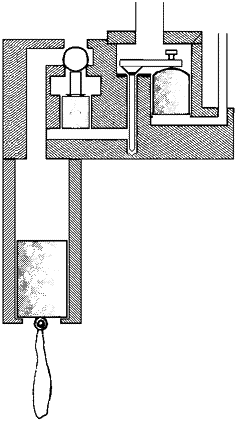"The Player Piano -- Its construction, How to play,
What to play and how to preserve it and make
adjustments when necessary", by D. Miller Wilson
The Pistonola. This instrument is manufactured by Boyd Ltd., London.
The action is all metal and works with a tension twenty-five times greater
than that usually employed in pneumatic players. The action can be
installed into a piano of ordinary dimensions.
Instead of bellows, self lubricating pistons are used, fitted in a single
row of metal cylinders. The pistons are made of a special composition
of graphite, compressed and moulded with a glass-like surface, and work
silently. The air chambers are so small that a metal block 4.75 inches
by 1.5 inches contains nine complete striking pneumatics.
The device for accenting melody notes is called the modulist, and is
controlled from marginal perforations in the music roll. There is
also a device called the crescodant by means of which crescendos and diminuendos
are obtained. The following explains the modus operandi of the pistonola
action.
When a perforation in the music roll opens the duct in tracker bar,
air passes down the tracker tube and up under the plunger situated in the
front part of valve block, the air then lifts plunger, this in turn lifts
a small cone valve (called primary) off its seating, the air then passes
down by the stem of the valve at the back of valve block; this valve
consisting of washer discs, plunger and ball is called the secondary valve.
The air lifts ball off its seating by means of washer and plunger up
to top of the seat, thereby shutting off the ball chamber from the atmosphere;
this chamber is in communication with the cylinder by means of a hole in
the side, another hole leading from this at right angles direct into cylinder,
the air space above the piston in cylinder is now in direct communication
with the main air supply by means of opening under ball seat, the air in
space above piston is now drawn out by suction of the pumps, causing the
atmosphere on the outside to push the piston up, lifting the whippen by
the connecting cord.
Normally the air in space above piston is in communication by means
of the seat opening above ball. While a note is being played there
is a partial vacuum above the piston, but as soon as a hole in the tracker
bar is shut off by the music roll the valve falls back and the air from
the atmosphere passes back through top seat, opening the ball chamber and
then into cylinder, the piston then falls into normal position. |

The primary valve (right) is supplied with tension from the roll motor
regulator. Feeder tension from the reservoir is applied to the rectangular
chamber above the secondary valve piston (left). |
 Gallery
Gallery
 Pictures
Pictures
 Pistonola
Pistonola
 pistonola_descr1
pistonola_descr1
